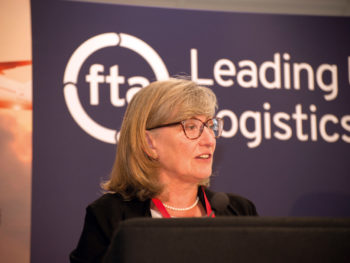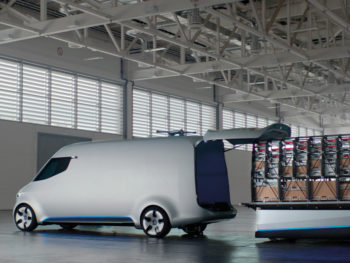Autonomy, connectivity and electrification point the way to a very different van of the future, says Dan Gilkes.

With van sales continuing to grow, the future for the van market looks assured. But just what will that future look like? That was the question being asked at a recent FTA Future Van conference. With rapid change on the horizon, driven by legislation and a wide range of new technologies, tomorrow’s light commercial vehicles and the way in which we use them could be quite different to today.
“We expect smart roads by 2025, with autonomous lanes in use by 2030,” said Denise Beedell, policy manager, vans and urban transport for the FTA. “Between 2025 and 2030, we are expecting to see accompanied autonomous commercial vehicles in use, with manual roles reduced and by 2050 there will be no HGV driver requirement at all.”
That’s quite a prediction, though one that would solve the current truck driver shortage at least. But it seems that the rate of development looks set to speed up further, driven by the desire to cut emissions, increase efficiency and reduce congestion on our roads. Yet, while many operators seem keen to get on board with this new vision for the future, there are very few vehicle manufacturers actually capable of satisfying demand for electric vans.

The FTA has conducted research of 30 member companies that have had some experience of operating electric light commercials. This included large and small businesses, though 50% of respondents run at least 1,000 vehicles in their fleets. Of that number, 52% had purchased electric vans, while 48% had opted to lease E-LCVs. Nissan’s e-NV200 was by far the most popular model in use.
“Frustration was the biggest comment, with limited vehicles available, particularly at the heavier end,” said Beedell. “There is a really strong desire to go to an electric van, but a lot of frustration that vehicles are still not readily available.”
Sam Clarke, founder of central London electric van delivery company Gnewt, agreed: “We’ve been deploying electric vehicles in the UK, but there’s a real lack of vehicles over 3.5-tonnes,” he said.
Operators also wanted more than just a panel van, looking instead for tippers and dropsides, in particular for local authority and utility work. That said, the majority of fleets also wanted to buy from recognised brands, rather than new start-ups. Interestingly, many had discovered that, despite a higher initial purchase price, the overall whole-life operating cost of an electric vehicle was similar, if not better than its diesel counterpart.
Simon King, fleet and procurement director at facilities management giant Mitie, runs a fleet of 3,500 vans and 2,500 cars. However, with an average 80-mile range for the E-LCVs, he has only been able to change 24% of the fleet to some form of electric drive. That said, he claimed that even with only a quarter of the fleet using electric, the company is seeing savings of more than £1m a year, as the SMR costs for an EV are a fraction of those of an ICE vehicle. Indeed, Mitie is considering extending the life of its fleet vehicles, as the SMR costs are so low and they don’t suddenly rise as the vehicle gets older.

If anyone is in doubt about the move to electric vehicles, or indeed the reasons for that move, Fergus McVey put forward some compelling arguments. The CEO of 7th Sense Research UK, McVey said that fleets will not only move to zero carbon vehicles because of climate change, but that it will be financially sensible to do so. Certainly, the fact that Amazon has recently ordered 100,000 electric vehicles from US company Rivian should point the way forward.
“The internal combustion engine is already a horse,” he said, pointing to the demise of conventional drivelines.
His company’s research shows that we will move to per-mile pricing, which will include vehicle leasing, insurance and road pricing. Indeed, his research shows that while there is still a desire for companies to own vehicles, that will reduce as we move towards a pay-for-use model. This will include vehicle sharing, with vehicle batteries used to assist the grid during downtime.
“There will be no more ICE; photovoltaic-equipped vehicles will make you money. But there will be no need to own it, you will be sharing vans,” said McVey.
However, he is not so convinced by the rush to automation and driverless vehicles, saying that it will be virtually impossible to get to the highest levels of vehicle autonomy.
“I think full automation is pretty unlikely. Assisted automation is where we see it ending up,” he said.
The changing face of last-mile deliveries…
We are constantly told that the increase in last-mile deliveries, driven mainly by internet shopping, has created highly efficient logistics operations. To some extent that is true.
Yet, it seems it is not always the case. Indeed, both Sam Clarke of Gnewt and Claire Thompson-Sage, sustainable development co-ordinator at parcel giant UPS, feel that we need to come back from same-day or next day deliveries to increase efficiency.
“It’s the changing landscape of human behaviour, people want things now,” said Thompson-Sage. “But 9am delivery drives inefficiency.”
“There is no such thing as free delivery,” added Clarke.
Both would prefer to see more use of consolidation centres, where deliveries are brought together to increase efficiency and cut down on the use of half-empty delivery vehicles. Indeed, Gnewt has already started to push towards this with some customers. In one case the company was delivering 15-20 times a day to a single big business customer in central London. By asking the company to use consolidation, bringing together all of the parcels into a single delivery per day, it was possible to use one vehicle to make one journey, massively boosting productivity and contributing to reducing traffic on the roads.
However, to achieve that sort of change in delivery patterns across the industry would require some form of Government intervention, as no delivery business wants to be the first to say no to a customer to a customer, as they will simply look elsewhere.

